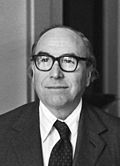Election results
Elections in the 1950s
| Party | Candidate | Votes | % | ±% | |
|---|---|---|---|---|---|
| Labour | Roy Jenkins | 33,077 | 58.5 | ||
| Conservative | Edith Pitt | 20,699 | 36.6 | ||
| Liberal | Sydney Walter Haslam | 2,789 | 5.0 | ||
| Majority | 12,378 | 21.9 | |||
| Turnout | 56,565 | 83.4 | |||
| Labour win (new seat) | |||||
| Party | Candidate | Votes | % | ±% | |
|---|---|---|---|---|---|
| Labour | Roy Jenkins | 34,355 | 59.5 | +1.0 | |
| Conservative | Edith Pitt | 23,384 | 40.5 | +3.9 | |
| Majority | 10,971 | 19.0 | −2.9 | ||
| Turnout | 57,739 | 81.4 | −2.0 | ||
| Labour hold | Swing | ||||
| Party | Candidate | Votes | % | ±% | |
|---|---|---|---|---|---|
| Labour | Roy Jenkins | 23,358 | 58.4 | −1.1 | |
| Conservative | Joseph Morris Bailey | 16,618 | 41.6 | +1.1 | |
| Majority | 6,740 | 16.8 | −2.2 | ||
| Turnout | 39,976 | 72.7 | −8.7 | ||
| Labour hold | Swing | ||||
| Party | Candidate | Votes | % | ±% | |
|---|---|---|---|---|---|
| Labour | Roy Jenkins | 21,919 | 53.6 | −4.8 | |
| Conservative | Joseph Morris Bailey | 18,996 | 46.4 | +4.8 | |
| Majority | 2,923 | 7.2 | −9.6 | ||
| Turnout | 40,915 | 73.5 | +0.8 | ||
| Labour hold | Swing | ||||
Elections in the 1960s
| Party | Candidate | Votes | % | ±% | |
|---|---|---|---|---|---|
| Labour | Roy Jenkins | 22,421 | 56.8 | +3.2 | |
| Conservative | David Knox | 17,033 | 43.2 | −3.2 | |
| Majority | 5,388 | 13.6 | +6.4 | ||
| Turnout | 39,454 | 71.0 | −2.5 | ||
| Labour hold | Swing | ||||
| Party | Candidate | Votes | % | ±% | |
|---|---|---|---|---|---|
| Labour | Roy Jenkins | 24,597 | 64.2 | +7.4 | |
| Conservative | David Knox | 12,727 | 33.2 | −10.0 | |
| Communist | William Dunn | 998 | 2.6 | New | |
| Majority | 11,871 | 31.0 | +17.4 | ||
| Turnout | 38,322 | 70.2 | −0.8 | ||
| Labour hold | Swing | ||||
Elections in the 1970s
| Party | Candidate | Votes | % | ±% | |
|---|---|---|---|---|---|
| Labour | Roy Jenkins | 22,559 | 56.2 | −8.0 | |
| Conservative | John B Stevens | 15,848 | 39.5 | +6.3 | |
| National Democratic | Douglas Hardy | 1,483 | 3.6 | New | |
| Communist | Sidney Pegg | 298 | 0.8 | −1.8 | |
| Majority | 6,711 | 16.7 | −14.3 | ||
| Turnout | 40,188 | 63.8 | −6.4 | ||
| Labour hold | Swing | ||||
| Party | Candidate | Votes | % | ±% | |
|---|---|---|---|---|---|
| Labour | Roy Jenkins | 23,704 | 53.1 | −3.1 | |
| Conservative | David John Wedgwood | 13,472 | 30.1 | −9.6 | |
| Liberal | Graham Gopsill | 7,221 | 16.2 | New | |
| Workers Revolutionary | Royston Bull | 280 | 0.6 | New | |
| Majority | 10,232 | 23.0 | +6.3 | ||
| Turnout | 44,677 | 72.1 | +8.3 | ||
| Labour hold | Swing | ||||

| Party | Candidate | Votes | % | ±% | |
|---|---|---|---|---|---|
| Labour | Roy Jenkins | 23,075 | 57.6 | +4.5 | |
| Conservative | David John Wedgwood | 11,152 | 27.8 | −2.3 | |
| Liberal | Graham Gopsill | 5,860 | 14.6 | −1.6 | |
| Majority | 11,923 | 29.8 | +6.8 | ||
| Turnout | 40,087 | 64.1 | −8.0 | ||
| Labour hold | Swing | ||||
| Party | Candidate | Votes | % | ±% | |
|---|---|---|---|---|---|
| Conservative | Andrew MacKay | 15,731 | 43.4 | +15.6 | |
| Labour | Terence Davis | 13,782 | 38.0 | −19.6 | |
| National Front | Andrew Brons | 2,955 | 8.2 | New | |
| Liberal | Graham Gopsill | 2,901 | 8.0 | −6.6 | |
| International Marxist | Brian Heron | 494 | 1.4 | New | |
| Socialist Workers | Paul Foot | 377 | 1.0 | New | |
| Majority | 1,949 | 5.4 | N/A | ||
| Turnout | 36,240 | ||||
| Conservative gain from Labour | Swing | ||||
| Party | Candidate | Votes | % | ±% | |
|---|---|---|---|---|---|
| Labour | Terry Davis | 21,166 | 48.4 | −9.2 | |
| Conservative | Andrew MacKay | 19,517 | 44.6 | +16.8 | |
| Liberal | Graham Gopsill | 2,349 | 5.4 | −9.2 | |
| National Front | F. Russell | 698 | 1.6 | New | |
| Majority | 1,649 | 3.8 | −26.0 | ||
| Turnout | 43,730 | 71.6 | +7.5 | ||
| Labour hold | Swing | ||||